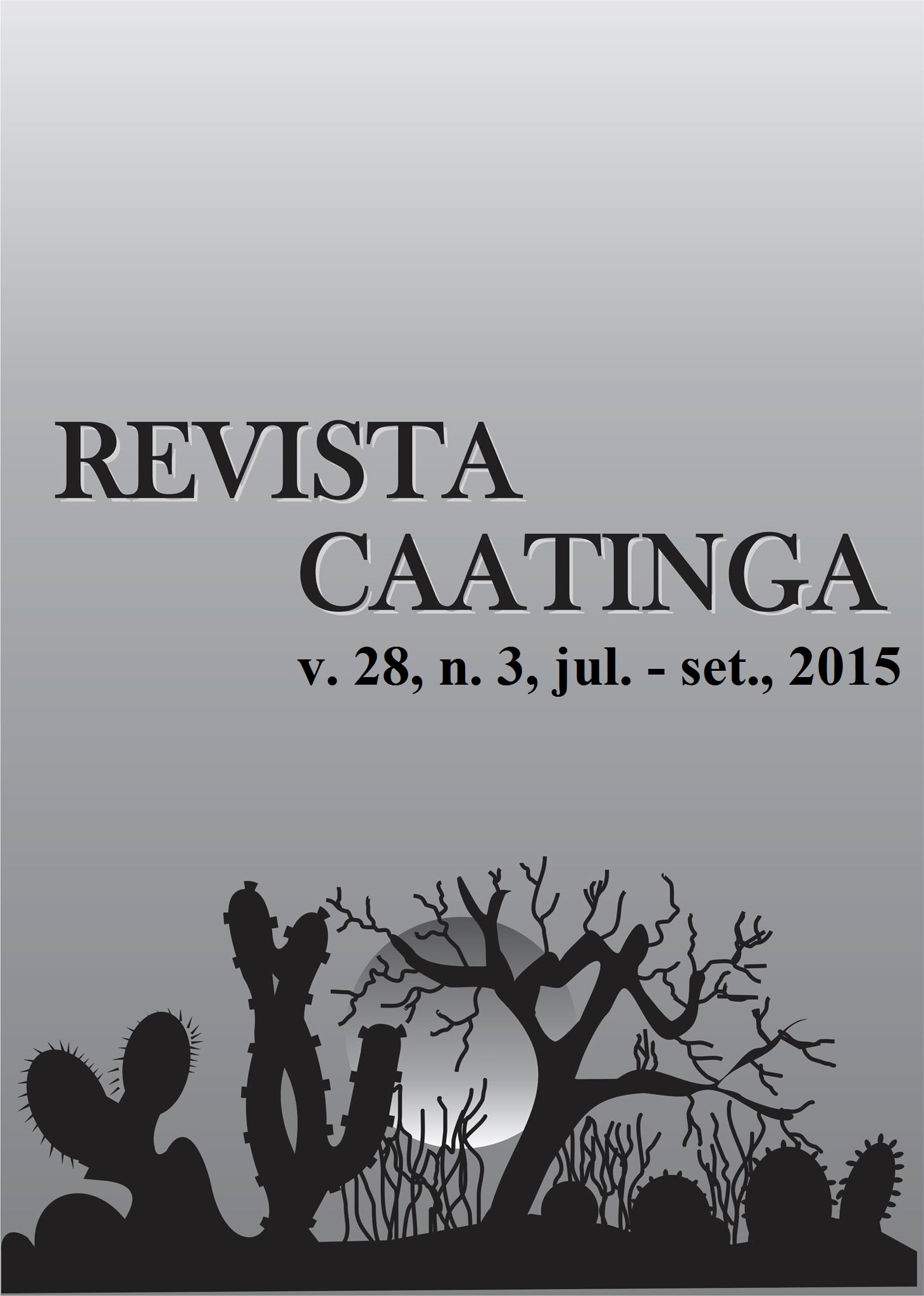CHEMICAL COMPOSITION AND DIGESTIBILITY OF PORNUNÇA UNDER TWO SOURCES OF ORGANIC FERTILIZER
DOI:
https://doi.org/10.1590/1983-21252015v28n324rcKeywords:
Manure. Native forage. Manihot sp. Semiarid.Abstract
The objective of this Study was to evaluate the effect of organic fertilizer and cuts on the chemical composition and in vitro digestibility of the air pornunça biomass. The experimental design of randomized blocks in a split plot with four courts, two fertilization, and four replications. The cuts were made in February, June and October 2011 and February 2012. The fertilizer was with cattle and sheep manure, applied in May 2010 and March 2011 in the amount of 20 Mg ha-1. We evaluated the structural components of the shoot, such as leaf blade, petiole, branch and full (leaf blade and petiole more branch) of pornunça. The manure beef and lamb did not influence (P>0.05) the chemical composition of the structural components of the shoot. Differences were noted between the cuts, except for dry matter (DM) of the leaf blade and the full component of ether extract (EE), neutral detergent fiber (NDF), acid detergent fiber (ADF) and hemicellulose (HC). There was a significant (P<0.05) for the in vitro digestibility of the MS of the structural components in different cuts, with the highest digestibility for structural components in the cut made in February 2011. Lower crude protein was found in the petiole and components branch. The pornunça should be considered as an alternative food for animals according to the chemical composition of the values presented in this study, with the leaf surface of the plant part that presents the best nutritional value.Downloads
References
BERCHIELLI, T. T.; GARCIA, A. V.; OLIVEIRA, S. G. Principais técnicas de avaliação em estudo de nutrição. In: BERCHIELLI, T. T.; PIRES, A. V.; OLIVEIRA, S. G. (Ed). Nutrição de Ruminantes. Jaboticabal, Funep, 2006. p. 397-418.
EMBRAPA – Sistema brasileiro de classificação de solos. SANTOS, H. G. et al. 2 ed. Rio de Janeiro: EMBRAPA Solos, 2006. 306 p.
FERREIRA, A. L. et al. Produção e valor nutritivo da parte aérea da mandioca, maniçoba e pornunça. Revista Brasileira de Saúde e Produção Animal, Salvador, v. 10, n. 1, p. 129-136, 2009.
FERREIRA, D. F. Manual do sistema Sisvar para análises estatísticas. Lavras, Universidade Federal de Lavras, 2000. 66 p.
FRANÇA, A. A. et al. Anatomia e cinética de degradação do feno de Manihot glaziovii. Acta Scientiarum. Animal Sciences, Maringá, v. 32, n. 2, p. 131-138, 2010.
GALVÃO, S. R. S.; SALCEDO, I. H.; OLIVEIRA, F. F. Acumulação de nutrientes em solos arenosos adubados com esterco bovino. Pesquisa Agropecuária Brasileira, Brasília, v. 43, n. 1, p. 99-105, 2008.
MENEZES, R. S. C.; SALCEDO. I. H. Mineralização de N após incorporação de adubos orgânicos em um Neossolo Regolítico cultivado com milho. Revista Brasileira de Engenharia Agrícola e Ambiental, Campina Grande, v. 11, p. 361-367, 2007.
MENEZES, R. S. C.; SILVA, T. O. Mudanças na fertilidade de um neossolo regolítico após seis anos de adubação orgânica. Revista Brasileira Engenharia Agrícola e Ambiental, Campina Grande, v. 12, n. 3, p. 251-257, 2008.
MOREIRA FILHO, E. C. et al. Composição química de maniçoba submetida a diferentes manejos de solo, densidades de plantio e alturas de corte. Revista Caatinga, Mossoró, v. 22, n. 2, p. 187-194, 2009.
PARAÍBA, G. E.; SECTMA; AESA. Caracterização do Solo. Classes de Solos. Solos do Estado da Paraíba. Disponível em: <http://www.aesa.pb.gov.br/perh/relatorio_final/Capitulo%202/pdf/2.11%20-%20CaracSolo.pdf >. Acesso em: 13 de mai. 2012.
PARENTE, H. N. et al. Influência da adubação nitrogenada sobre o crescimento inicial e composição química e mineral da maniçoba (Manihot sp.). Revista Científica da Produção Animal, Areia, v. 9, n. 2, p. 102-110, 2007.
PEREIRA, V. L. A. et al. Valor nutritivo e consumo voluntário do feno de faveleira fornecido a ovinos no semiárido pernambucano. Revista Caatinga, Mossoró, v. 25, n. 3, p. 96-101, 2012.
SANTOS, M. V. F. et al. Potential of caatinga forage plants in ruminant feeding. Revista Brasileira de Zootecnia, Viçosa, v. 39, p. 204-215, 2010. (Suplemento especial).
SILVA, D. J.; QUEIROZ, A. C. Análise de alimentos: métodos químicos e biológicos. Viçosa: UFV, 2006. 235 p.
TILLEY, J. M. A.; TERRY, R. A. A two-stage technique for the in vitro digestion of forage crops. Journal of British Grassland Society, Oxford, v. 18, n. 2, p. 104-111, 1963.
VAN SOEST, P. J. Nutritional ecology of the ruminant. 2. ed. Ithaca: Cornell University, 1994. 476 p.
VASCONCELOS, W. A. et al. Morfometria, produção e composição bromatológica da Maniçoba e Pornunça em resposta a diferentes fontes de adubação. Revista Trópica – Ciências Agrárias e Biológicas, Chapadinha, v. 4, n. 2, p. 36 - 43, 2010.
VOLTOLINI, T. V. et al. Alternativas alimentares e sistemas de produção animal para o semiárido brasileiro. In: SÁ, I. B.; SILVA, P. C. G. (Eds.). Semiárido brasileiro: pesquisa, desenvolvimento e inovação. EMBRAPA SEMIÁRIDO, Petrolina, p. 199-242, 2010.
Downloads
Published
Issue
Section
License
Os Autores que publicam na Revista Caatinga concordam com os seguintes termos:
a) Os Autores mantêm os direitos autorais e concedem à revista o direito de primeira publicação, com o trabalho simultaneamente licenciado sob a Licença Creative Commons do tipo atribuição CC-BY, para todo o conteúdo do periódico, exceto onde estiver identificado, que permite o compartilhamento do trabalho com reconhecimento da autoria e publicação inicial nesta revista, sem fins comerciais.
b) Os Autores têm autorização para distribuição não-exclusiva da versão do trabalho publicada nesta revista (ex.: publicar em repositório institucional ou como capítulo de livro), com reconhecimento de autoria e publicação inicial nesta revista.
c) Os Autores têm permissão e são estimulados a publicar e distribuir seu trabalho online (ex.: em repositórios institucionais ou na sua página pessoal) a qualquer ponto antes ou durante o processo editorial, já que isso pode gerar alterações produtivas, bem como aumentar o impacto e a citação do trabalho publicado (Veja O Efeito do Acesso Livre).







